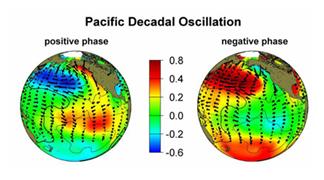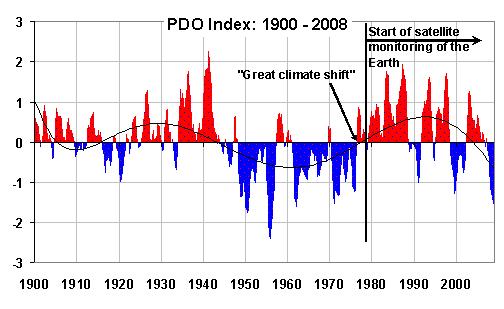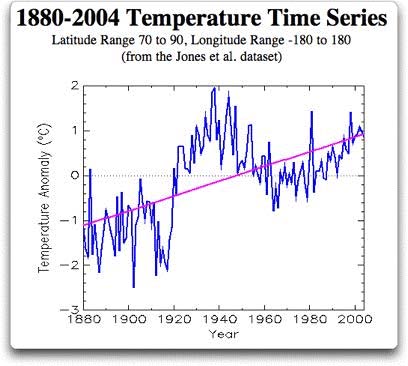The Pacific Decadal Oscillation (PDO): Key to the Global Warming Debate?

The Pacific Decadal Oscillation
The Pacific Decadal Oscillation (PDO) is an internal switch between two slightly different circulation patterns that occurs every 30 years or so in the North Pacific Ocean. It was originally described in 1997 in the context of salmon production. It has a positive (warm) phase that tends to warm the land masses of the Northern Hemisphere, as well as a negative (cool) phase.
Like the El Nino and La Nina oscillation of the tropical Pacific (also called the El Nino – Southern Oscillation, or ENSO), the PDO represents two different average circulation states that the ocean-atmosphere system seems to have a difficult time choosing between. But whereas ENSO changes every few years, the PDO changes every thirty years or so. This long time scale makes the PDO a potential key player in climate change.

In fact, I now believe that the PDO is critical to our understanding of global warming. This is because a change in weather circulation patterns can cause a small change in global-average cloudiness. And since clouds represent the single largest internal control on global temperatures (through their ability to reflect sunlight), a change in cloudiness associated with the PDO might explain most of the climate change we’ve seen in the last 100 years or more.
For instance, after the “Great Climate Shift of 1977” when the PDO went from its negative to positive phase, the Arctic region began to warm. Satellite monitoring of Arctic sea ice just happened to begin soon thereafter (in 1979), and as you probably know from the news media reports, the yearly summer melt season has seen a gradual loss of ice cover since then. In late 2007, the Northwest Passage opened, a rare event that allows ships to travel the relatively short distance between the Atlantic and Pacific Oceans through the Arctic.
But while the warming and loss of Arctic sea ice in the last 30 years is popularly attributed to mankinds’ production of carbon dioxide from fossil fuel use, similar events occurred in the 1920s and 1930s, with disappearing sea ice, changing wildlife patterns, and the opening of the Northwest Passage in 1939 and 1940. Arctic temperatures were just as warm then as they are now.

And now, as of late 2008, it looks like we might have entered into a new, negative (cooling) phase of the PDO. Only time will tell whether this pattern persists.

 Home/Blog
Home/Blog



